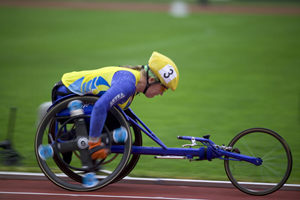| The pupils are to learn to explain what fitness is and the connection between pulse, heart rate, and respiration. They are to be able to make suggestions on how one can engage large groups of muscles so that one increases the pulse rate and thus respiration as well. They are to be able to plan an investigation: formulate hypotheses, test their hypotheses, collect relevant data, interpret data, discuss their data and to present their results and conclusions. |
|
This task requires pupils to plan and carry out an investigation. One can adapt the instructions: the amount of freedom given to the pupils is dependent upon how used they are to working with this type of task. Distribute the worksheet with the story below. The pupils should work in groups of two or three.

The woman in the picture seems to be very fit. It is obvious that she could not acquire such a good level of fitness by running, which otherwise is a common way to train. What sort of exercise can she do instead to increase her fitness?
When muscles are active the muscle cells need oxygen and glucose which are transported to them when the heart beats. An efficient heart pumps more blood in each heartbeat, thus transporting more oxygen with fewer beats than a heart in the body of an unfit person. If you train regularly, you can perform more work with the same number of heartbeats than if you do not train. In order for the heart to work hard, it is important to engage large muscle groups in fitness training.
- Firstly, discuss with the pupils what fitness and fitness training is. What is a normal pulse at rest, and how high can the pulse rise? Then discuss what one can do to increase the heartbeat rate - and therefore respiration – without using the muscles in the legs.
- Hypothesis The pupils write down their hypotheses
- Planning an investigation Divide the pupils into groups. Now they need to agree on testing some of their hypotheses. The pupils must decide which activities they are to do, what they are to measure (pulse), how they are to measure it, whereabouts on the body and how many times. It is more interesting if the groups do different types of investigations. Should they do a series of measurements on one person, or should several people do the same thing? It is important that the pupils test only one variable at a time.
- Data collection The pupils carry out the measurements they have planned, and record their results
- Interpreting and discussing the data Give the pupils sufficient time to discuss their data and the way it has been collected. What did they measure? What differences did they observe and what can have caused these? Where the pulse was measured? The differences between individuals? The differences between the various series of measurements? Differences between the activities? Did they measure the right thing? Did they measure carefully enough?
It is also important to discuss source errors and consider what is and what is not comparable.
- Reporting of data Ask the pupils to record their results in the form of tables, graphs, diagrams etc.
- Conclusions What is fitness training? What happens to the body in fitness training? What activities do the pupils suggest that the woman in the wheelchair should perform?
- Divide the pupils into new groups so that they can cross-reference their investigations and results, and in this way practise communicating and explaining their results.
|
